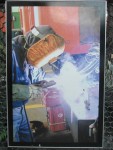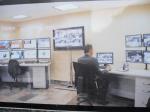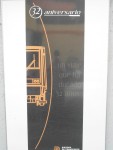Just under a month on from the completion of the first quarter, the MCM Project has now made it halfway in this epic journey. That’s right! 74 of the 148 stations that currently make up the Mexico City Metro Network have been visited and documented on this page. So it is time to look back on some of the happenings of this second quarter of the project and also to give you a little bit of extra information about the Mexico City Metro.
The second quarter started at Balbuena where I feasted on some tasty Yucatecan snacks, there was market madness at Merced and a clown adding colour to drabness at La Paz.
Lawyers and old-timers kept me company around Doctores, great retro street art stood out at San Antonio Abad and a 900 kg Korea – Mexico friendship bell rang true whilst cosplay enthusiasts basked under the golden sun in Bicentenary Park near Refineria.
The MCM project came home for visit number 50 with a street art tour around Isabel La Catolica.
Then there was the impossibly named Camarones (Shrimp) Station where organ grinders were just one part of the flurry of activity.
Stalin, Lenin and Marx aptly showed their faces in the ‘First of May’ neighborhood around Romero Rubio, more old-timers dusted off their dancing shoes and got their groove on around Division Del Norte and a revolutionary artisan appeared on the scene at Cuitlahuac.
A canine pal led me to great tacos at the station where Frida Kahlo first entered the project – Constituyentes, I made new friends at Refugees’ House near Hospital General and I entered the head of ex-president Benito Juarez in my roaming around Guelatao.
A step back in time at Tepalcates, a Sunday pilgrimage to La Villa-Basilica and finally a jug of pulque to celebrate the completion of the first half of the project close by to Patriotismo.
And all that is just a smattering of what was the second quarter of the MCM Project.
Last week during my wanderings (near Salto de Agua – station to come) I happened to come across the Metro Network Headquarters. Surrounding the precinct there is a photographic exhibition which documents the life, history and construction of the Mexico City Metro. I learnt quite a bit about the Mexico City Metro in relation to other Metro systems in the world;
- It is the eighth largest metro system in the world in number of stations after New York, Paris, Seoul, Madrid, London, Tokyo and Berlin.
- With 11 currently in operation (Line 12 under construction) the metro also ranks eighth in number of lines after New York, Paris, Cologne, Madrid, Tokyo, London and Moscow.
- With an annual average of 1417 million passengers (wow! almost 1 and a half billion!) it is the fifth most patronized metro after Tokyo, Moscow, Seoul and New York.
- The Mexico City Metro started operating on September 4 1969 ( just over a month after man first landed on the moon) making it the world’s 31st metro system. The first was opened in London on January 10 1863.
- With 201 kilometres of track it is the world’s ninth longest after London, New York, Tokyo, Seoul, Madrid, Moscow, Shanghai and Paris.
- The 3 peso ticket price makes the Mexico City Metro System the world’s fifth cheapest after Chennai and Kolkata in India, Kazan in Russia and Dnipropetrovsk in Ukraine.
Below are some photographs from the exhibition.
Back soon for station # 75!
Thanks for following the first half of the project!
Un poco menos de un mes desde la terminación del primer cuarto, el MCM Project ahora se ha acabado con la mitad del recorrido. Es verdad! 74 de las 148 estaciones que actualmente constituyen el sistema del metro de la Ciudad de México fueron visitadas y documentadas en esta pagina. Por lo tanto es buena hora de revisar algunos de los acontecimientos del sugundo cuarto del proyecto y también proporicionarte un poco de información extra acerca del Metro de la Ciudad de México.
El segundo cuarto empezó en Balbuena donde disfruté de unos antojitos yucatecos, había locura del mercado en Merced y un payaso que añadio color a la sosería de La Paz.
Abogados y ancianos me hicieron compañia alrededor de Doctores, arte callejero retro y bien chido destacó en San Antonio Abad y una campana de la amistada corea-méxico que pesa 900kg sonó mientras fanaticos de cosplay gozaban del sol dorado en el Parque Bicentenario cerca de Refineria.
El MCM Project volvió a casa por la visita numero 50 con un tur del arte callejero alrededor de Isabel La Catolica.
Entonces había la estación con el mejor nombre – Camarones donde organilleros fueron solamente una parte de mucha actividad.
Stalin, Lenin y Marx apropriadamente mostraron sus caras en la colonia ‘Primero de Mayo’ alrededor de Romero Rubio, más ancianos limpiaron el polvo de sus zapatos de baile y salieron a bailar cerca de Division Del Norte y un artesano revolucionario apareció en la escena por Cuitlahuac.
Un amigo canino me guió a tacos riquisimos en la estación donde Frida Kahlo entró al proyecto – Constituyentes, hice amigos nuevos en la ‘Casa Refugiados’ cerca de Hospital General y entré a la cabeza de Benito Juarez, ex-presidente de México, en mi caminata por Guelatao.
Un paso atras en tiempo en Tepalcates, una peregrinación dominical a La Villa-Basilica y finalmente una jarra de pulque para celebrar el fin de la primera mitad del proyecto cerca de Patriotismo.
Y todo eso es solamente una selección de lo que fue el segundo cuarto del proyecto.
La semana pasada durante una caminata (cerca de Salto de Agua – estación por venir) hallé por casualidad la sede central del Metro. Alrededor del recinto hay una exposición de fotografía que documenta la historia, vida y construcción del metro de la Ciudad de México. Aprendi bastante sobre el sistema de aqui en relación a otros sistemas de metro en el mundo;
- Por numero de estaciones ocupa el octavo lugar después de New York, Paris, Seoul, Madrid, Londres, Tokio y Berlin.
- También ocupa el octavo lugar por sus 11 lineas (Linea 12 bajo construcción) después de New York, Paris, Cologne, Madrid, Tokio, Londres y Moscú.
- Tiene un promedio de 1417 millones de pasajeros anualmente por lo cual ocupa el quinto lugar después de Tokio, Moscú, Seoul y New York.
- El Metro de la Ciudad de México inició sus operaciones el 4 de Septiembre de 1969 (un mes y pico después de que hombre se puso pie en la luna por primera vez). El primer metro del mundo se inaguró en Londres el 10 de Enero de 1863.
- Con 201 kilometros de longitud ocupa el noveno lugar detrás de Londres, New York, Tokio, Seoul, Madrid, Moscú, Shanghai y Paris.
- El costo del boleto es tres pesos lo cual hace que ocupa el quinto lugar en metros más economicos del mundo detrás de Chennai y Kolkata de la India, Kazan de Rusia y Dnipropetrovsk de Ucrania.
Arriba hay unas fotos de la exposición.
De vuelta pronto por la estación # 75!
Gracias por seguir la primera mitad del proyecto!





























































